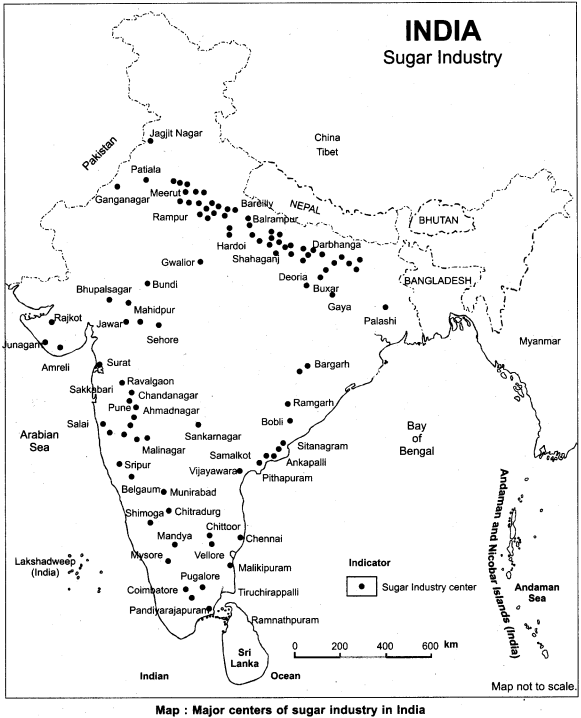Rajasthan Board RBSE Class 12 Geography Chapter 19 Industry
RBSE Class 12 Geography Chapter 19 Text Book Questions
RBSE Class 12 Geography Chapter 19 Multiple Choice Questions
Question 1.
Biggest sugar producing state of India is:
(a) Uttar Pradesh
(b) Bihar
(c) Maharashtra
(d) Tamil Nadu
Answer:
(c) Maharashtra
Question 2.
Where is the newly established railway coach factory situated?
(a) Banaras
(b) Raibareli
(c) Kapurthala
(d) Porbandar
Answer:
(d) Porbandar
Question 3.
For the foundation of cement industry, the presence of which raw material is most effective?
(a) limestone
(b) Manganese
(c) Gypsum
(d) None of these
Answer:
(a) limestone
Question 4.
With which country’s collaboration was the iron and steel plant established in Bokaro?
(a) U.S.A.
(b) Former Soviet Union
(c) Britain
(d) Germany
Answer:
(b) Former Soviet Union
Question 5.
Tata Iron and Steel Plant gets iron ore from:
(a) Bailadila
(b) Mayurbhani
(c) Singhbhum
(d) Bonai
Answer:
(c) Singhbhum
Question 6.
Which industry the first to be started in India?
(a) Textile industry
(b) Iron industry
(c) Jute industry
(d) Marble industry
Answer:
(a) Textile industry
Question 7.
In India which industry is mostly centralized near the regions of raw material?
(a) Iron and Steel
(b) Woolen clothes
(c) Sugar
(d) Cotton textile
Answer:
(c) Sugar
Question 8.
The iron and steel plant established near coal regions is:
(a) Bhadravati
(b) Bokaro
(c) Jamshedpur
(d) Visakhapatnam
Answer:
(b) Bokaro
Question 9.
In which state are the cotton textile industries in largest number?
(a) Maharashtra
(b) Gujarat
(c) Tamil Nadu
(d) Madhya Pradesh
Answer:
(a) Maharashtra
Question 10.
The center of heavy engineering industry is:
(a) Ranchi
(b) Bengaluru
(c) Hyderabad
(d) Pune
Answer:
(b) Bengaluru
Question 11.
In which state is the cement industry most developed?
(a) M.P.
(b) Rajasthan
(c) Gujarat
(d) Karnataka
Answer:
(a) M.P.
RBSE Class 12 Geography Chapter 19 Very Short Answer Type Questions
Question 12.
For which minerals is Jhariya famous?
Answer:
Jhariya is a famous coal mine. It is famous for coal production.
Question 13.
In which state is Lakheri situated?
Answer:
Lakheri is situated in Bundi district of Rajasthan.
Question 14.
Write the full form of TISCO.
Answer:
Tata Iron and Steel Company.
Question 15.
In which Indian city is the iron pillar (Lauh stambh) situated?
Answer:
It is situated near Qutub Minar in Delhi.
Question 16.
When and where was the first cement industry to produce cement using sea shells in India?
Answer:
In India, the first organised attempt to make cement from sea shells was done in Madras in 1904.
RBSE Class 12 Geography Chapter 19 Short Answer Type Questions
Question 18.
Mention three problems of engineering industry.
Answer:
This industry is the base of industrialization of any country. Three major problems of this industry are given below:
1. Lack of Raw Material:
Steel which is used in making spare parts has to be imported.
2. Lack of Capital:
This industry needs a lot of capital, so the factories are established in the public sector.
3. Excessive Tax Burden:
Due to heavy tax on production, difficulty arises in export.
Question 19.
Raw material works as magnet for Industries, write a note.
Answer:
Industries are classified into two parts:
- Weight loss industries.
- Non – weight loss industries.
In the first type industry, raw material is used in much quantity and has much weight. So, concerned industry is established near sources of raw material, because it supports less transportation expenses in sending goods to the market, such as iron – steel industry, sugar industry cement industry are such types of industries which are attracted towards the sources of raw material. Non-weight lose industries are exempted from such problems.
Question 20.
Write down the names of main centers of aircraft manufacturing industry.
Answer:
The first attempt in this field was done in 1940 in Bengaluru, in the form of Hindustan Aircraft Limited. In 1964, Hindustan Aeronotics limited was founded. Its units are located in Bengaluru, Kanpur, Nashik, Koraput, Hyderabad and Korba (Lucknow).
Question 21.
Describe the features of Visakhapatnam iron and steel plant.
Answer:
On the basis of modern technique, this is the first plant to be established which is situated at sea port. Due to being near to the port, it is easy to export and import. For iron and steel plant:
- Iron ore is obtained from Bailadila mines.
- Coal is obtained from Damodar Valley.
- Manganese, dolomite and limestone is obtained from the mines of Chhattisgarh and Odisha.
From this plant, during the year 2008 – 09, 29.4 lakh tons of hot metal, 26.2 lakh tons of liquid steel and 23.8 lakh tons of sale able steel was produced.
Question 22.
Write down responsible factors for the development of cement industry in Rajasthan.
Answer:
Rajasthan is one of the major cement producing state in India, Lakheri, Nimbahera, Chittorgarh, Udaipur, Beawar etc. are main centres. Following factors are responsible for development of cement industry:
- Local availability of gypsum and limestone.
- Extended market facility.
- Adequate transport facilities.
- Substantial capital.
- Cheap electric power.
- Availability of adequate labour force, etc.
Question 23.
Explain why sugar industry is shifting towards Southern India from Northern India.
Answer:
In the past few decades, sugar industry in India is shifting from Northern India to Southern India. Following are the reasons:
- In South India, sugarcane yield per hectare is higher, sugarcane contains more amount of juice and sweetness.
- The geographical condition/available for sugarcane production are more suitable in southern India than northern India.
- The black soil here is more suitable for sugarcane cultivation.
- Sugar mills of south India provide sugarcane cultivation on the basis of ownership, which provide them manufacturing time necessary sugarcane.
- Sugar and sugarcane manufacturing time period is relatively higher in South India.
- In South India, in sugar mills, new machines and techniques are used.
- More transportation and traffic facilities are available.
RBSE Class 12 Geography Chapter 19 Essay Type Questions
Question 24.
Discuss briefly the development of cotton textile industry in India. This industry is more centralized in Maharashtra Why?
Answer:
In India, cotton textile is an ancient and traditional industry. Its record is found in the manuscripts of Herodotus (434 BC), discovery of Harappa and Mohenjo – daro (5000 to 8000 BC) and in the Pyramids of Egypt. In ancient time, Roman women took pride in wearing Indian silk and Chintz. In ancient, time the entire textile work was done by handlooms. Major centers were present between Nagapatnam and Dhaka on the eastern coast and Surat – Bharuch situated on the western coast.
In India, modern were industry was started in Kolkata, in 1818 by Kavas Ji Dabur. The number of mills became 12 by 1861. The number of mills increased to 417 by 1945. After independence, continuous development took place in cotton textile industry. At present, this industry is providing employment to almost 4.5 crore people. The number of organised mills in textile industry is 1969. Out of these, 1717 are spinning and 198 are composite mills. In India, the consumption of cloth per person per year was 43.1 square meter in 2009 – 10.
Causes of Much Centralization in Maharashtra and Gujarat:
Following are the causes:
- In both states, climate is wet due to coastal location. This is ideal for cotton textile.
- Black soil is found in both states which is more suitable for cotton production.
- Due to coastal location import and export facilities are there.
- Due to large population in both states, sufficient market is found here.
- Due to development of transportation, ideal conditions have emerged.
- Inclination of people of these states towards industries and capital availability provided ideal condition to this industry.
Question 25.
Describing the centralization of iron and steel industry in India, mention its distribution.
Answer:
This is a basic industry of India. This industry was started in 1870. Its modern form was started by Jamshed Ji Tata. He founded a modern factory in 1907 at Sakchi (Jamshedpur).
Cause of Localistion:
Iron and Steel industry is established at such places, where heavy raw material such as coal, iron ore, limestone, maganese etc. can easily be obtained from. In India iron and steel industry has been established in different areas:
- Near coal fields – Burnpur, Hirapur, Kulti, Durgapur, Bokaro.
- Near iron ore regions – Bhilai, Rourkela, Bhadrawati, Selam, Vijayanagar.
- Between coal and iron ore regions – Tata steel company.
- Coastal area and Trade facilities – Visakhapatnam.
Besides raw material, following factors also effect the localisation of iron &. steel industry:
- Cheap transportation, specially water transport facilities.
- Pure water availability.
- Capital availability.
- Expert and cheap labour.
- Closeness to market.
- Favorable political environment.
Distribution of Iron and Steel Industry:
In India, iron and steel industry has been mainly established in West Bengal, Jharkhand, Madhya Pradesh, Chhattisgarh, Tamil Nadu, Andhra Pradesh, Karnataka, Odisha etc. Here, all types of raw material are available.
Major Units of Irons and steel Industry in India:
These are given below:
1. Tata Iron and Steel Company:
This is the first big company established in 1907 by Jamshed Ji Tata. It is situated on Kolkata-Nagpur railway route at Sakchi (Jamshedpur) in Singhbhum district of Jharkhand.
2. Indian Iron and Steel Company:
It is the oldest steel company. It has three units – Kulti, Burnpur and Hirapur. In Kulti unit, steel iron, and in Hirapur and Burnpur units, Pig. iron and steel are produced.
3. Visvesvaraiya Iron and Steel Works Limited:
This company was established in 1923 at Bhadrawati in Shimoga district of Karnataka. Here, electrically operated blast furnaces are installed for making best quality steel.
4. Rourkela Steel Plant:
This plant is established in Sundargarh district of Odisha 415 km away from IColkata at a place named Rourkela which is on the railway route of Mumbai – Nagpur – Kolkata. It is established with the collaboration of Germany.
5. Bhilai Steel Plant:
This company is established in Bhilai with Russian collaboration. It is in Durg district 21 km away from Raipur in the west at a place called Bhilai on the railway route of Durg to Raipur.
6. Durgapur Steel Plant:
It is established at Durgapur with collaboration of British government. It is on the bank of the river Damodar in Bardhaman district of West Bengal on Kolkata – Asansol railway route.
7. Bokaro Steel Plant:
This plant is situated at Bokaro in Dhanbad district of Jharkhand. It has been established with Russian collaboration during the fourth five year plan.
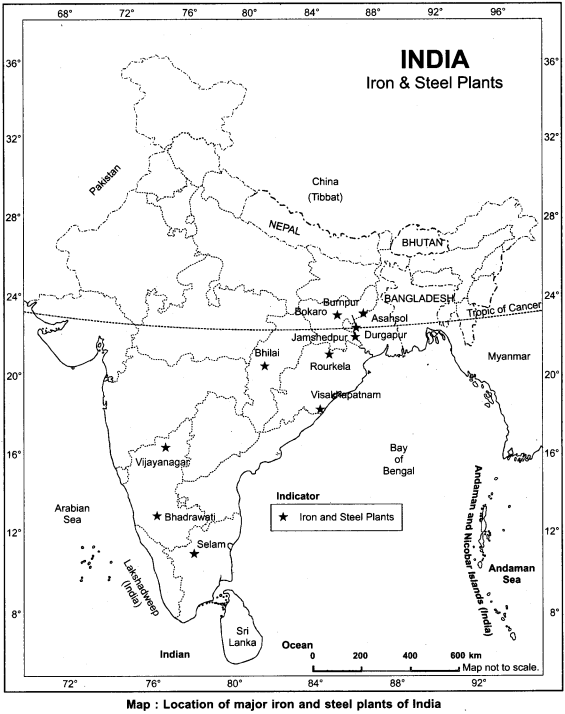
8. Vijayanagar Steel plant:
It is established near Hospet of Bellari district of Karnataka. It is fully based on Indian technique.
9. Visakhapatnam Steel Plant:
It is first steel plant of India which is situated on the sea coast. It is established by National Ispat Nigam Ltd. at Vishakapattnam of Andhra pradesh.
10. Selam Steel Plant:
It is in Selam district of Tamil Nadu. It is established to manufacture special steel. It is engaged in production since 1982.
In India, iron and steel plants have been shown with the help of the given map on previous page number 432.
Question 26.
Describe in detail about aluminium industry of India.
Answer:
It is the second most important industry after iron and steel. This industry is mainly located near coal and electricity producing regions. Aluminium is used to make household utensils, electric wires, building construction, defense material, railway coach, aircraft, motor car, in nuclear programe and in making furniture, etc.
Development of the Industry:
In India, in 1886, first production of aluminium was started using electronic method. Utensils making work from imported aluminium was started in 1929 in India.
In India, the beginning of Aluminium industry took place in 1937 in J. K. Nagar (West Bengal) when a plant was set up under Aluminium Corporation of India. In 1941, Indian Aluminium Company started making aluminium sheets from imported aluminium rolls.
Distribution:
Distribution of aluminium plants is given below:
1. Indian Aluminium Company Limited:
Its main unit is in Muri. Its one additional unit is opened in Hirakund area. The second plant has been started in Belgaum.
2. Aluminium Corporation of India:
This factory is situated in J. K. Nagar (Near Asansol). Here aluminium, aluminium rolls and sheets making work is done on a single place itself.
3. Hindustan Aluminium Corporation Limited:
This factory is situated in Renukoot near Mirzapur in son river valley. It is a completely organised firm where whole work is done at the same place.
4. Madras Aluminium Limited:
This factory is situated in Mettur. Its capacity is 25 thousand tons.
5. National Aluminium Company Limited:
This company was started on January 7, 1981 for obtaining alumina and aluminium products. This is the biggest company of the country.
6. Bharat Aluminium Company Limited:
On November 27, 1965, this company was started as the primary aluminium products enterprise in the public sector. This company has been conducting Korba aluminium package in Bilaspur area of Chhattisgarh and Vidhan Bagh unit in Asansol (West Bengal).
In 2008, Vedanta Aluminium Limited has started working. India is at the first place in aluminium production and the third largest country also in consumption. With bauxite deposits points of view, it is the fifth largest country of the world.
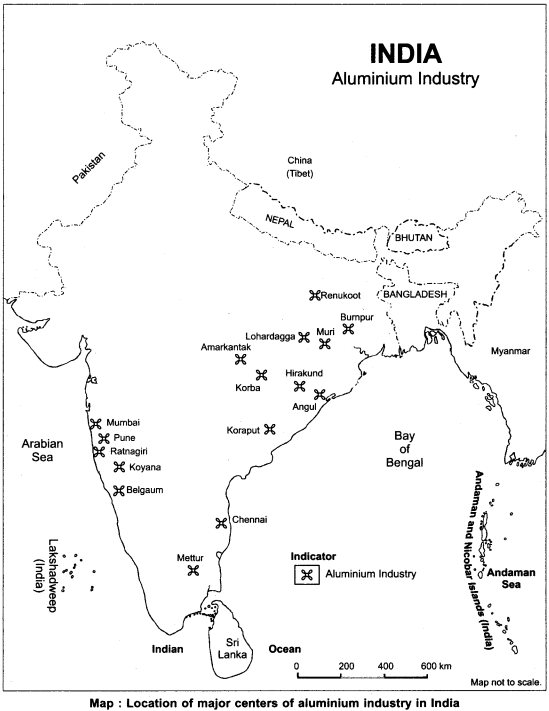
RBSE Class 12 Geography Chapter 19 Additional Questions with Answers
RBSE Class 12 Geography Chapter 19 Multiple Choice Questions
Question 1.
In ancient time, India was called the:
(a) Golden bird
(b) Diamond bird
(c) Silver bird
(d) All these
Answer:
(a) Golden bird
Question 2.
Where was shipyard company founded first in (1941)?
(a) Kolkata
(b) Visakhapatnam
(c) Chennai
(d) Calicut
Answer:
(b) Visakhapatnam
Question 3.
After Independence, in which year was the industrial policy first declared?
(a) In April, 1948
(b) In March, 1950
(c) In July, 1952
(d) In September, 1954
Answer:
(a) In April, 1948
Question 4.
In the beginning, in India, which tribe used to do iron related work?
(a) Bheel
(b) Naga
(c) Agaria
(d) Munda
Answer:
(c) Agaria
Question 5.
According to year 2014, what is Indian rank in raw steel production?
(a) First
(b) Second
(c) Third
(d) Fourth
Answer:
(d) Fourth
Question 6.
Which is not included in the units of ISCO in India?
(a) Kulti
(b) Burnpur
(c) Bhilai
(d) Hirapur
Answer:
(c) Bhilai
Question 7.
Durgapur steel plant has been established with collaboration of:
(a) Former Sovient Union
(b) British government
(c) German government
(d) None of these
Answer:
(b) British government
Question 8.
Which of the following steel plants is based on indigenous technology?
(a) Durgapur
(b) Bhilai
(c) Vijayanagar
(d) Bokaro
Answer:
(c) Vijayanagar
Question 9.
What is Indian rank in cement production?
(a) First
(b) Second
(c) Third
(d) Fourth
Answer:
(c) Third
Question 10.
Satna and Maihar of Madhya Pradesh are famous for which of the following industries?
(a) Iron and steel industry
(b) Cement industry
(c) Engineering industry
(d) Cotton textile industry
Answer:
(b) Cement industry
Question 11.
Which is the biggest cement factory of Gujarat?
(a) Porbandar
(b) Dwarka
(c) Sikka
(d) Ahmedabad
Answer:
(c) Sikka
Question 12.
Which is called the capital of cotton textile?
(a) Ahmedabad
(b) Kanpur
(c) Bengaluru
(d) Mumbai
Answer:
(d) Mumbai
Question 13.
Famous center of bicycle manufacturing in India is:
(a) Kanpur
(b) Lucknow
(c) Ludhiana
(d) Nagpur
Answer:
(c) Ludhiana
Question 14.
Famous center of information technology in India is:
(a) Kanpur
(b) Patna
(c) Bengaluru
(d) Kolkata
Answer:
(c) Bengaluru
Match the Following
Question 1.
Match the option given in Column A to Correct option given in Column B:
| Steel Plant (Column A) | States (Column B) |
| (i) TISCO | (A) Odisha |
| (ii) Rourkela | (B) Tamil Nadu |
| (iii) Bhilai | (C) Andhra Pradesh |
| (iv) Durgapur | (D) Karnataka |
| (v) Vijayanagar | (E) Chhattisgarh |
| (vi) Selam | (F) West Bengal |
| (vii) Visakhapatnam | (G) Jharkhand |
Answer:
(i) – (G), (ii) – (A), (iii) – (E), (iv) – (F), (v) – (D), (vi) – (B), (vii) – (C)
RBSE Class 12 Geography Chapter 19 Very Short Answer Type Questions
Question 1.
Why was India called the golden bird?
Answer:
In ancient times, India was advanced in making best quality clothes, ornaments, decorative items. Thus, in exchange of these ready articles, gold came to India from other countries. Thus, it was called ‘The golden bird’.
Question 2.
What were the causes of decline of Indian handicrafts?
Answer:
Two causes were there:
- Exploitation policy during British period.
- Industrial revolution.
Question 3.
Which kind of industries got encouragement during British time?
Answer:
Two industries got encouragement:
- British industry which was unable to fulfill the demand of Indian market (as – cotton clothes, woolen clothes, cement industry).
- Those industries whose raw material was not profitable to be carried to Britain (such as – sugar and jute industries).
Question 4.
When and where was the first failed attempt of establishment of iron and steel industry done?
Answer:
It was done in Arcot district of Tamil Nadu in 1779.
Question 5.
When and where was the first failed attempt of establishment of cement industry done?
Answer:
It was done in Chennai in 1904.
Question 6.
When and where was the first plant of Chemical fertilizer industry established?
Answer:
It was established in Ranipet (Tamil Nadu) in 1906.
Question 7.
What was the aim of the industrial policy declared in 1923?
Answer:
It’s aim was to earn profit from world war situations by encouraging Industrial development.
Question 8.
Where was the first (failed) mill of paper industry established?
Answer:
It was established in Serampore of West Bengal.
Question 9.
When and where was the first woolen mill established?
Answer:
It was established in Kanpur in 1876 under the brand name Lalimli.
Question 10.
When was the National Planning Commission in India first established?
Answer:
It was first established in March, 1950.
Question 11.
Why is iron and steel industry known as basic industry?
Answer:
It is called because products of this industry are required in making all other goods. In fact, iron and steel industry is the industry of all industries.
Question 12.
Which was the first unit of public sector of iron and steel industry?
Answer:
It was Visakhapatnam Iron and Steel Works founded in 1923 in Bhadrawati.
Question 13.
When was Steel Authority of India Limited founded?
Answer:
It was founded in 1974 by the government.
Question 14.
Which Indian iron and steel company belongs to the private sector?
Answer:
It is Tata Iron and Steel Company (TISCO) in Jamshedpur.
Question 15.
What is the official status of Visakhapatnam steel plant?
Answer:
It is under (RINL)Rastriya Ispat Nigam Limited.
Question 16.
When did the government acquire the ownership of TISCO [Indian Iron and Steel Company?
Answer:
Acquiring the ownership on July 14, 1976, the government merged it with SAIL. Referenced merger was accepted to be from April 1, 2005.
Question 17.
What all raw material is required to prepare 1 ton of Pig iron?
Answer:
According to an estimate, to make one ton of pig iron, 1.5 ton Iron ore, 1.4 ton coal, 0.3 ton limestone, 0.1 ton manganese and 0.1 ton dolomite are required.
Question 18.
Name the iron steel plants located near Coal fields?
Answer:
Burnpur, Hirapur, Kulti, Durgapur, Bokaro.
Question 19.
Name the iron and steel industries located near iron ore fields.
Answer:
Bhilai, Rourkela, Bhadrawati, Selam and vijayanagar (Karnataka).
Question 20.
Name the iron and steel center located on port.
Answer:
The only iron and steel center situated on port is at Visakhapatnam.
Question 21.
Which units are included in TISCO?
Answer:
Kulti, Burnpur, and Hirapur.
Question 22.
What are the sub – products obtained from Rourkela steel plant?
Answer:
Light oil, essential oil, nepthalene, oil, wash oil, Anthracene oil, pitch etc. are obtained in the form of sub – products from Rourkela steel plant.
Question 23.
Which is the successful and ideal iron and steel industry of India?
Answer:
Bhilai.
Question 24.
Name two major aims of national Steel Policy (November 2005).
Answer:
Following are the aims:
- Bringing input cost at world level.
- Increasing competition in quality and production.
Question 25.
Where is Durgapur steel plant situated?
Answer:
This plant is situated on Asansol – Kolkata Railway route in Bardhaman district of West Bengal on the bank of Damodar river.
Question 26.
Which is necessary raw meterial for aluminium industry?
Answer:
Bauxite.
Question 27.
What are the problems of aluminium industry?
Major problems include competition with foreign market, incapability to increase exports, centralization of power resources, high cost of production, domestic big market etc.
Question 28.
What is the rank of National Aluminium company (NALCO) in Asian continent?
Answer:
By producing 21 lakh tons of Aluminium per year, it is at first rank in Asia.
Question 29.
Who established a cement company in Katni (M.P.)?
Answer:
It was established by Khatau company.
Question 30.
Who established Lakheri cement factory in Rajasthan?
Answer:
It was established by Killick Nixon company in Bundi.
Question 31.
Who collaborated in the Porbandar (Gujarat) cement factory?
Answer:
Tata Sons.
Question 32.
Where is the biggest plant of cement situated in the country?
Answer:
Jamul (M.P.).
Question 33.
Name major cement producing regions of Madhya Pradesh.
Answer:
Satna, Maihar, ICaisun, Gopal Nagar, Ankal, Tara Banyor, Neemuch, Gwalior, Katni and Damoh are major cement plants.
Question 34.
Which are major cement producing regions of Rajasthan?
Answer:
Lakheri, Nimbahera, Chittorgarh, Udaipur, Beawar, Modak etc.
Question 35.
Name major cement producing districts of Karnataka.
Answer:
Bagalkor, Bari, Bhadrawati, Bengaluru, Kurkanta, Shahbad, Aamsandra, Bijapur, Tumkur and Gulbarga etc.
Question 36.
Name cement producing regions of Jharkhand.
Answer:
Son river valley is significant in context to cement industry. Sindri, Dalmianagar, Japla, Khelari, Chaibasa, Banjari and Kalyanpur have cement industries.
Question 37.
Describe major problems of cement industry.
Answer:
Huge capital requirement, lack of electricity, lack of coal availability, lack of goods carriage, lack of water etc. are major problems of cement industry.
Question 38.
What did Herodotus (434 BC) write about cotton textile industry of India?
Answer:
Answer:
Herodotus visited Ihdia in 434 BC and wrote that, “Indians wear beautiful clothes made of plants of white Indian flower”.
Question 39.
What did the Roman women take pride in?
Answer:
They took pride in wearing Indian silk and chintz.
Question 40.
What is called the capital of cotton textiles?
Answer:
Mumbai is called the capital of cotton textiles.
Question 41.
Which is called the Bostan of the east?
Answer:
Ahmedabad.
Question 42.
What did Traveneir say regarding Indian cotton textile industry?
Answer:
“Indian silk was beautiful because when it is in your hand, it is not felt. It was woven by highly delicate spinned thread. That piece of malmal clothes could be passed through a ring.”
Question 43.
What did Bukanan write about cotton textile industry of India?
Answer:
Bukanam has written about cotton textile industry of India that, “For India, cotton textile industry has been the pride of the past, problem of the present, and a hope forever”.
Question 44.
Which is the most important center of cotton textile industry in Tamil Nadu?
Answer:
It is coimbatore, where 50% mills of the state are established.
Question 45.
Which is the major center of cotton textile industry in U. P.?
Answer:
Kanpur is the main center of cotton textile industry in U.P. It is called the Manchester of North India.
Question 46.
Name any two industries based on agriculture.
Answer:
Agriculture – based industries are:
- Cotton textile
- Jute textile.
Question 47.
Where is the description of sugar industry of India available in ancient books?
Answer:
It is available in Vedic literature, Chanakaya’s Arthashastra and Megasthenes’s Indica.
Question 48.
Where was the first successful sugar mill established in India?
Answer:
In year 1908, by the Britishers, first successful sugar mill was established at Marhaura in Bihar.
Question 49.
Which is the major center for producing sugar in Maharashtra?
Answer:
Ahmednagar is the biggest sugar producing center in Maharashtra. Here, 11 sugar mills are established.
Question 50.
At what places are the sugar mills present in Rajasthan?
Answer:
The sugar mills are at Keshoraipatan (Bundi), Bundi, Shriganganagar and Bhupalsagar in Rajasthan.
Question 51.
What is the belief of scholars regarding the engineering industry?
Answer:
According to the scholars, Without engineering industry, the machines of development can not proceed a single step ahead.
Question 52.
What type of things are produced by engineering Industry?
Answer:
By engineering industry, many types of mixed metals, different machinery, machine tools are produced.
Question 53.
In India with whose collaboration, heavy engineering industry was established?
Answer:
In India, heavy engineering industry was established by Heavy Engineering Corporation Limited in the year 1957 in Ranchi with collaboration of Russia and Czechoslovakia.
Question 54.
What is Indian position in manufacturing of Industrial machinery?
Answer:
India is self – dependent in manufacturing of Industrial machinery and some machinery is also exported to African and Asian countries.
Question 55.
Name major centers of heavy electric Engineering.
answer:
For the manufacruting of electerical appliances in India, Bharat Heavy Electricals Limited (BHEL) was established in public sector in the year, 1964. Its plants are in Bhopal, Hyderabad, Haridwar, Panipat, Bengaluru, and Jamshedpur.
Question 56.
What is the condition of Bicycle Industry in India?
Answer:
In context to bicycle Industry, India is at the second major rank after China. At present, the major center is Ludhiana in India.
Question 57.
Where was the primary factory of making Railway engines established?
Answer:
The primary factory for making Railway engine is established in Ajmer and Jamalpur [Bihar] by the Railway department. Till the year 1940, in workshop of Ajmer, 446 engines, and 346 boilers were made. At present, they have been closed.
Question 58.
Where are the railway Coaches manufactured in India?
Answer:
In India, the Railway coach factory in Public sector is the integral Coach Factory at Perambur [Tamil Nadu]. Here, oridnary and air conditioned passenger coaches are made.
Question 59.
Why is Bengaluru known as Silicon Valley of India?
Answer:
The information technology industry has developed significantly in Bengaluru. Thus, it is called Silicon Valley of India.
Question 60.
Where are the units of Indian Telephone Industries located?
Answer:
In year 1950, Indian Telephone Industry was established in Bengaluru. Its units are in Shrinagar, Raebareli, Naini (Allahabad).
Question 61.
Where is Indian Electronics Limited located? What type of products are manufactured by it?
Answer:
Indian Electronics Limited is located in Bengaluru. It manufactures electronic equipments related to Army, Meteorology, Radio broad casting.
Question 62.
India exports engineering equipments to which countries?
Answer:
From India, engineering equipments are exported to countries such as America, China, Britain, Russia and this export is increasing steadily.
Question 63.
Explain two objectives of ‘Make in India’ programme.
Answer:
The major objectives of this programme are:
- To accelerate the pace of industrial development by promoting investment.
- Making the country a manufacturing hub. The formal beginning of Make in India programme took place on September 25, 2014.
RBSE Class 12 Geography Chapter 19 Short Answer Type Questions (SA-I)
Question 1.
Name iron and steel centers of public sector under Steel Authority of India Limited (SAIL).
Answer:
In the ownership of sail, following plants are present in public sector:
- Durgapur integrated steel plant, Durgapur (W. B.)
- Rourkela integrated steel plant, Rourkela (Odisha)
- Bhilai integrated steel plant, Bhilai (Chhattisgarh)
- Bokaro integrated steel plant, Bokaro (Jharkhand)
- Indian iron and steel company, Burnpur (W. B.)
- Special and mixed steel and iron mixed factory Durgapur (W. B.)
- Special and mixed steel and iron mixed factory Selam (Tamil Nadu)
- Maharashtra electro Selam limited Chandrapur (Maharashtra)
- Visvesaraiya iron and steel company Bhadrawati (Karnataka)
Question 2.
How does raw material effect the position of industries?
Or
Clarify how does raw material effect the centralization of industries?
Answer:
There is a close relationship between raw material and industrial development. Generally, weight loss oriented industries are established at places where the raw material is available. The industry whose products’ weight is low in comparison with raw materials, can be established any where away from the market. But the industries using heavy raw material, are established near the raw material sources, such as iron and steel industry, sugar industry.
Question 3.
How do power resources influence the location of heavy industries in India?
Answer:
To conduct the work speedily in industries, different types of machines are used. These machines directly or indirectly are operated by power resources. So, closeness and availability of power resources is the main factor to control the industry, thus aluminium industry’ is established near power resources because it needs much power.
Question 4.
How does market affect the position of an industry?
Answer:
Market is necessary to absorb the goods produced by industries. Closeness to market reduces transport expenses, and consumers get the products at low price. The goods which decompose quickly cannot be carried to distant places. Consequently, closeness to market is considered necessary in foundation of industries such as cotton textile industry and oil refineries.
Question 5.
The best location of iron and steel industry is near the source of raw material, why?
Or
Why are iron and steel plants located near raw material sources in India? clarify it.
Answer:
Various kinds of raw material are needed in this industry, in which iron ore, coal, lime stone, dolomite, manganese and coke are important. All these raw materials are of weight loss nature. Thus, the location of iron and steel industries is suitable near raw material sources. That is why, Indian iron and steel plants are situated near the areas of raw material sources.
Question 6.
In India, which area is the most suitable for establishment of iron and steel industry?
Answer:
In India, Chhattisgarh, Northern Odisha, Jharkhand and western parts of West Bengal are included in such a crescent-moon region which has highly favorable conditions for the establishment of iron and steel industry. In this region, there is abundance of high quality iron ore, coaking coal and other raw materials. That is why in this eastern part of the country in crescent-moon regions, most of the development of this industry has taken place.
Question 7.
Name major iron & steel plants of India.
Or
Which are integrated steel plants of India?
Answer:
- Tata Iron and Steel Company
- Indian Iron and Steel Company
- Visvesvaraiya Iron and Steel Works (Karnataka)
- Rourkela Steel Plant (Odisha)
- Bhilai Steel Plant (Chhattisgarh)
- Durgapur Steel Plant (West Bengal)
- Bokaro Steel Plant (Jharkhand)
- Visakhapatnam Steel Plant (Andhra Pradesh)
- Vijayanagar Steel Plant, Hospet (Karnataka)
- Selam Steel Plant (Tamil Nadu)
Question 8.
Clarify the location of Tata Iron and Steel Company.
Answer:
Tata Iron and Steel Company (TISCO):
This plant is located near Mumbai – Kolkata railway route in Jamshedpur in Jharkhand. This plant obtains iron ore from Noamandi and Badam Hills, coal from mines situated in the state of Odisha, coaking coal from Jharia and western Bokaro and water from Subarnarekha and Kharkai river.
Question 9.
What do you know about Indian Iron and Steel Company?
Answer:
The iron and steel plants of IISCO are established at places namely-Hirapur, Kulti and’ Burnpur near Asansol (State of West Bengal). Above these steel plants are located near railway route of Kolkata – Asansol of Damodar valley’s coal fields (RaniGanj, Jharia and Ramgarh). For these plants, iron ore is supplied from Singhbhum (Jharkhand) and water is supplied from Barak river which is a tributary of Damodar river.
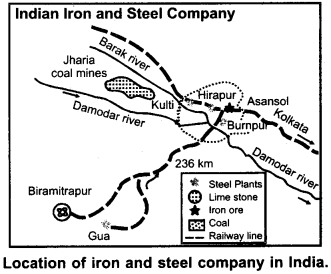
Question 10.
Clarify the location of Bhilai steel plant.
Answer:
Bhilai Steel Plant:
This plant is established in Durg district of Chhattisgarh state with Russian collaboration. To this plant, supply of iron ore is done from nearby area of Dalli Rajhara mines and coal is obtained from Korba and Kargali mines. To this plant, electricity is supplied from Korba thermal power plant and water from Tandula dam. This plant is located on Kolkata – Mumbai rail route. The maximum part of steel produced in this plant is exported from Visakhapatnam port.
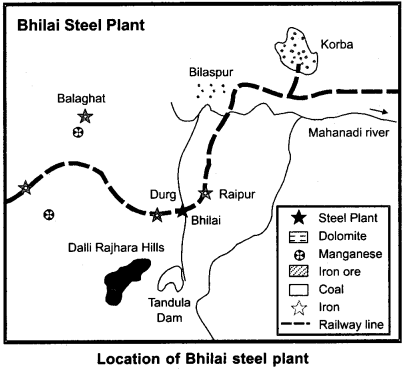
Question 11.
Describe the position of Durgapur steel plant along with map.
Answer:
Durgapur Steel Plant:
With collobaration of British government, this plant is operating in Durgapur in West Bengal. This plant comes in Raniganj and Jharia coal belt. This plant gets iron ore supplied from Noamundi area located on Kolkata – Delhi railway route. This plant gets hydro – electricity power from Damodar valley corporation.
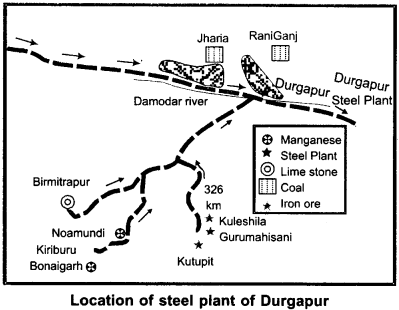
Question 12.
Show the location of Bokaro steel plant.
Answer:
Bokaro Steel Plant:
This plant is established at Bokaro of Jharkhand with Russian collaboration on the basis of minimum transportation cost theory, according to which Bokaro and Rourkela both jointly get iron ore from Rourkela area and in return coal is sent through the goods train. To this plant, electricity and water is supplied from Damodar Valley Corporation.
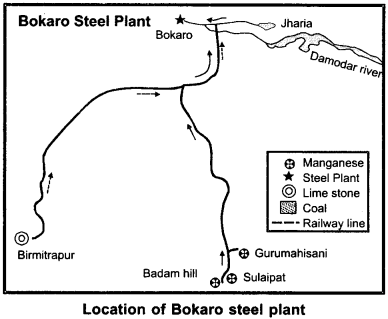
Question 13.
Show the location of Visvesvaraiya iron and steel works.
Answer:
This plant of iron and steel is operating at Bhadrawati in Karanataka near iron ore regions of Bababudan hills. To this plant, iron ore, limestonee and manganese are available at local level and water is supplied from the river Bhadrawati. In this plant, special steel and alloy is produced.
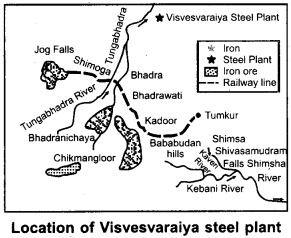
Question 14.
Can you outline the causes of the centralization of iron and steel industries in southern and eastern India?
Answer:
In the major causes of the centralization of iron and steel industries in northern India, closeness to coal and iron mines, availability of cheap electricity and water and transportation facilities are included, while in southern India, location of iron and steel industries depends on port facility and raw material supplied from nearby areas.
Question 15.
Write about Bokaro steel plant established on the basis of minimum transportation cost.
Answer:
Bokaro Steel Plant:
With Russian collaboration established at Bokaro in Jharkhand, this steel plant is founded on the basis of minimum transportation cost, according to which, Rourkela and Bokaro both jointly get iron ore from Rourkela region and in return coals are carried to Rourkela by goods train. Water and hydro – electricity to this plant is supplied from Damodar Valley Corporation.
Question 16.
Describe the production and trade of iron and steel in the last few years.
Answer:
In the year 2014 – 15, in India, the production of Pig iron was 9.634 million tons, sponge iron was 20.38 million tons and total ready steel (alloy + non alloy) production was 91.45 million tons. In the year 2014 – 15, 9.32 million tons of iron was exported from India.
Question 17.
What were the aims of National Steel Policy (2005)?
Answer:
On November 2, 2005, approval was given to National Steel Policy by the central government in which aim was fixed to increase production from 4 crore 21 lakh tons to 11 crore tons by 2019 – 20. To achieve this target, there is a possibility of investment of 2.5 lakh crore jointly by public and private sector.
Question 18.
What are the factors affecting centralization of cotton textile industry?
Answer:
This industry is one of the traditional industries .of India. The factors affecting its centralization are raw – material, cheap labour availability in local areas, closeness to the market, availability of cheap electricity, local investment and port facility etc.
Question 19.
What is the reason that most of the sugar mills are founded near sugarcane producing areas in India?
Answer:
Sugarcane is the only and most important raw material for sugar industry. In total weight of sugarcane, the weight of sucrose (sugar) is between 9% to 12%. Sugarcane is a weight loss agriculture crop. During cutting to loading period, quantity of sucrose reduces. If the juice from sugarcane is extracted in the sugar mills within 24 hours of its cutting, then the quantity of sugar obtained from it is the maximum. After this, the percentage of sugar declines as time passes. That is why most of the sugar mills are located near sugarcane producing regions. Thus, sugar industry is considered a raw material oriented industry.
Question 20.
Describe the location of Indian Aluminium Company.
Answer:
Indian Aluminium Company Moori is located at Muri in Jharkhand. The raw material required for this factory, Bauxite, is recieved from Lohardaga mines. It is 32 kilometers away from Muri. Water supply and coal is also received from Damodar Valley area. In this factory, aluminium rolls and sheets are manufactured, and the material produced here is sent to Alupuram, Belgaum and Thana.
Question 21.
Describe the development of the cement industry after achieving independence.
Answer:
After achieving Independence, the cement industry grew rapidly. In 1951, there were 21 plants in the country. In the year 1956, they increased to 27, in the year 1960 – 61, they increased to 34, in the year 1990 – 1991, they increased to 92. By the end of March 2015, there were 209 big cement plants in the country, with production capacity of 37.83 crore tons. Besides this, production of other 365 small plants was 33.63 million tons.
Question 22.
Describe cement producing areas of Madhya Pradesh.
Answer:
Madhya Pradesh is the major cement producing state of India. 12% of total cement production of India is produced here. Jamul Plant is the biggest cement factory. Apart from this, cement is also produced in Satna, Maihar, Kasoon, Gopalnagar Ankaltara, Banyor, Nimach, Gwalior, Katni and Damoh.
Question 23.
When did the Indian cottage industry (cotton textiles) receive a blow?
Answer:
Indian cotton industry continued till 18th century. The industrial revolution of Europe gave severe blow to this industry. The mechanical era has made this industry depleted. In India due to the development of railway route and opening of Suez Canal between the northern and western countries, this industry declined. Because of these reasons, the glory of Indian cotton textile industry disappeared in the womb of past.
Question 24.
What is the importance of cotton textile industry in context to India?
Answer:
This is the ancient industry of India. It has been a symbol of Indian glory and progress. Even today, a greater part of population is employed in cotton textile industry after agriculture. 14% of industrial product and 4% of gross domestic product is obtained from cotton textile production. 20% of the manufactured industrial production and 11% of the total exports are contributed by cotton textile.
Question 25.
Describe cotton textile producing areas of Maharashtra.
Answer:
Maharashtra state has first place in cotton textile production point of view. There are 181 mills in this state. Mumbai region is advanced in this regard. There are 57 cotton mills in this city. That is why, it is called the capital of cotton textile. In this state, cotton textile industries are situated in Sholapur, Akola, Amravati, Puna, Satara, Kolhapur, Sangli, Aurangabad, Jalgaon, and Nagpur etc.
Question 26.
Describe major sugar producing areas of Uttar Pradesh.
Answer:
Uttar Pradesh has second position in sugar production in the entire country. In this state, sugar industry is concentrated in two belts – Ganga – Yamuna doab and low land area. In Ganga – yamuna doab – Saharanpur, Muzaffarnagar, Meerut, Ghaziabad, Baghpat and Buland Shahar are the major sugar producing districts. While in low land regions, major sugar producing districts are – Lakhimpur, Khiri, Basti, Gonda, Gorakhpur and Bahraich etc.
Question 27.
Describe infrastructural industries.
Answer:
This is an important industry of construction industry. In it, infrastructure of steel plants, construction of railway bridges and hydrolic gate etc. are included. In it, total 250 industries are included having a total production capacity of 6 lakh tons. In this, (Allahabad), Tungabhadra (Karnataka), Bharat Heavy Plate and Vessals Limited Visakhapatnam, Larsen and Turbo Ltd, Pawai, Mumbai and Narora (Ahmedabad) are the main factories.
Question 28.
Where are machine tools units established in India?
Answer:
The items which are made of iron sheets are called machine tools. In India, 200 units are working. The foundation of Hindustan Machines Tools was done in 1953, with collabaration of Switzerland, which has nine plants. Bengaluru, Pinjore, Kalamseri, Hyderabad and Srinagar etc are centers under which equipment, watches and tractors are manufactured. Ajmer, Kota, Secunderabad etc. are public sector units of HMT.
Question 29.
Describe major motor industry of India.
Answer:
Automobile industry of the country is called ‘sunrise industry’. In 1944, Hindsutan Motor Company started work at Uttarpara in Kolkata. In 1947, Premier Automobile Ltd. was founded at Kurla in Mumbai. At this time, 35 units are working. There are 12 units in Maharashtra, 6 in Tamil Nadu, and 5 units in Delhi.
Question 30.
Write a note on passenger cars and other vehicles industry.
Answer:
In India, the first car was made by Maruti Udyog Ltd. Gurgaon, in 1983, with technical collaboration of Suzuki, Japan. Its present capacity is of 4 lakh vehicles each year. At this time:
- Premium Automobiles, Mumbai.
- Standard Motor Products, Chennai.
- Hyundai Motors India Ltd, Chennai.
- Mahindra and Mahindra Company Limited, Pune and Tata Locomotive Works etc. units are working.
Question 31.
Where are railway engines manufactured at present?
Answer:
The following two units are important:
- Chittaranjan Locomotive works Chittaranjan (West Bengal)
- Diesel Locomotive works, Varanasi.
Electric engines are manufactured in Chittaranjan while diesel engines are manufactured in Varanasi. The foundation of diesel component works by Indian Railway at Patiala has been done for repairing and maintaining railway engines.
Question 32.
Describe aircraft manufacturing industry in India.
Answer:
In India, the first attempt to make aircraft was done in 1940 in Bengaluru by Hindustan Aircraft Ltd. In 1964, Hindustan Aeronautics Limited was established in Bengaluru. Its units are situated in Bengaluru, Bengaluru, Nashik, Kanpur, Koraput, Hyderabad and Korba (Lucknow).
RBSE Class 12 Geography Chapter 19 Short Answer Type Questions (SA-II)
Question 1.
Compare Rourkela Steel Plant and Bhilai Steel Plant on the following basis:
1. Position
2. Sources of raw material
3. Water and energy supply
Answer:
| Basis of Difference | Rourkela Steel Plant | Bhilai Steel Plant |
| Position | This steel plant is located in Sundargarh district of Odisha with collaboration of Germany. | This steel plant is located in Durg district of Chhattisgarh with collaboration of former soviet union. |
| Source of raw material | This plant recieves raw material from nearby areas. It gets coal from Jharia, Raniganj, Talcher, iron ore from Kiriburu, Sundargarh, Keonjhar, Manganese from BaraJamda, Dolomite from Baradwar and limestone from Biramitrapur. | This plant gets raw material such as iron ore from nearby Dalli Rajhara hills, manganese from Bhandara and Balaghat, Dolomite from Hirri mines of Bilaspur, limestonee from Nandini mines, and coal from Bokaro of Jharkhand, Kargali, Jharia and Korba mines of Chhattisgarh. |
| Water and energy supply | This plant gets water supply from Koel and Shankh rivers and energy from Hirakund Hydroelectricity Powerhouse. | This plant gets water supply from Tandula dam and energy from Korba Thermal Powerhouse. |
Question 2.
Describe steel plant recently founded in Southern India.
Answer:
During fourth five year plan, three new steel plants were established which are far from raw material sources:
1. Vizag Steel Plant Visakhapatnam (Andhra Pradesh):
This plant is a co-port based steel plant in which production was started in 1992. This is the first plant situated on a port in India. This plant is based on modern technology. This plant gets high quality of Iron ore from Bailadila area of Bastar district.
2. Vijayanagar Steel Plant, Hospet (Karnataka):
This plant is based on the native technique, and it gets raw material from nearby areas of iron ore and limestone.
3. Selam Steel Plant, Selam (Tamil Nadu):
This plant was started in 1982. Mangnetite iron, lignite coal, limestone and dolomite etc. are available in sufficient quantity in this area. Its production capacity is 20 lakh tons.
Question 3.
Describe the factors of cotton textile development in India?
Answer:
Following factors are responsible:
1. India is a country of tropical climate. Cotton clothes are comfortable here in hot and semi-arid climate, so there is a great demand of cotton clothes in the country.
2. Cotton is the main raw material for this industry which is sufficiently produced in our country.
3. India is the second largest country of the world regarding population due to which labour is easily available for this industry. In various parts of India, people and their family have been making cotton clothes from generation, due to which the skill of making cotton clothes passes from generation to generation.
Question 4.
Why was first cotton mill established In Mumbai city In India 1854?
Answer:
Following were the causes:
- This city was very close to the cotton producing areas of Maharashtra and Gujarat.
- Cotton was exported to England through Mumbai port, so cotton was easily available in Mumbai city.
- At that time, Mumbai was a financial center and necessary capital was also available here to start the industry.
- There was easy availability of labour for cotton textile industry in sufficient quantity.
- Necessary modern machines could be easily imported from England for cotton textile industry.
Question 5.
Mention the cause of centralization of cotton textile industry in West Bengal.
Answer:
In West Bengal, near Kolkata, cotton textile mills are located in 24 Parganas, Howrah and Hooghly regions districts.
Following are main causes of centralisation of cotton textile industry over here:
- Facility of Kolkata port and closeness to south – east Asian countries.
- Import facilities.
- Availability of coal from Raniganj and Jharia.
- Developed transportation system.
- Availability of capital and trade facilities.
- Humid climate.
- Big local market.
- Backwardness of industries in north – eastern states.
Question 6.
Clarify the position of cotton textile producing states of India.
Answer:
Cotton textile producing states in India are:
| State | Percentage of Production |
| Maharashtra | 38.39 |
| Gujarat | 35.54 |
| Tamil Nadu | 6.40 |
| Punjab | 5.53 |
| Madhya Pradesh | 4.70 |
| Uttar Pradesh | 3.20 |
| Rajasthan | 2.80 |
| Pondicherry (Puducherry) | 2.45 |
| Karnataka | 0.32 |
| Kerala | 0.67 |
| Total | 100.0 |
Question 7.
Give a systematic detail of cotton textile production in India.
Answer:
Cotton textile production in India:
| Producing Year | Production in (Crore Square Meter) |
| 1950 – 51 | 421.5 |
| 1960 – 61 | 637.8 |
| 1970 – 71 | 759.6 |
| 1980 – 81 | 836.8 |
| 1990 – 91 | 2292.8 |
| 2000 – 01 | 4023.3 |
| 2007 – 08 | 5606.5 |
| 2008 – 09 | 5496.6 |
| 2011 – 12 | 3057.0 |
| 2012 – 13 | 6195.0 |
| 2013 – 14 | 4738.0 |
Question 8.
Give your suggestions for development of sugar industry in India.
Answer:
Following suggestions may be given:
- Proper arrangement of inspection.
- Replacement of machines.
- Establishment of mills near sugarcane producing belt.
- Emphasis to be given on research work regarding sugarcane crop.
- Cost should be decided with quantity of juice along with quantity of sugarcane.
- Arrangement of full year employment to the workers should be done;
- Tax system should be reformed.
- Payment should be given to sugarcane farmer at the time of scale.
- Full utilization of subsidiary/secondary produce.
Question 9.
Give a systematic detail of sugar production in India.
Answer:
Sugar Production in India:
| Producing Year | Production in (lakh tons) |
| 1960 – 61 | 30.20 |
| 1970 – 71 | 37.40 |
| 1990 – 91 | 120.46 |
| 2009 – 10 | 188.03 |
| 2010 – 11 | 243.49 |
| 2011 – 12 | 263.43 |
| 2012 – 13 | 251.83 |
| 2013 – 14 | 243.25 |
Question 10.
Describe the problems of engineering industry in India.
Answer:
Following are major problems of engineering industry:
1. Lack of raw material:
In this industry, raw steel is needed, and in India, It is imported.
2. Lack of capital:
Heavy capital is needed in this industry, so private sector contribution is less, hence most of the units are opened in the public sector.
3. Excessive tax burden:
Due to more tax on production, difficulty is there in export.
4. Other problems:
Foreign competition, incomplete use of production capacity and lack of quality control are some other problems in this regard.
Question 11.
Describe shipyard industry in India.
Answer:
In India, the first shipyard company was established in Visakhapatnam in 1941, by Scindia Steam Navigation Company, where first ship named Usha was built. In 1962, nationalisation was done of this company and it was known as Hindustan Shipyard Ltd. Visakhapatnam. Its major units are as follows:
1. Garden Reach Workshop:
It is situated at the bank of Hooghly river, here 15,000 – 25,000 ton capacity ships are built.
2. Goa Shipyard:
Here ships are made and repaired.
3. Mazagon Mumbai:
Here fidget type of ships are built for Indian navy.
4. Cochin Shipyard Ltd.:
This shipyard was built with Japanese collaboration in 1965 with an investment of 165 crore. It is the biggest shipyard of the country. Here manufacturing, repairing and training are done.
RBSE Class 12 Geography Chapter 19 Essay Type Questions
Question 1.
Describing the factors of localisation of cement industry in India, mention its major producing areas. .
Answer:
In this industry, raw material in large quantity is needed, limestone, gypsum, coal, etc. are raw material used in this industry. Thus, most of cement factories are established near the sources of raw material. Besides, following factors are necessary for localisation:
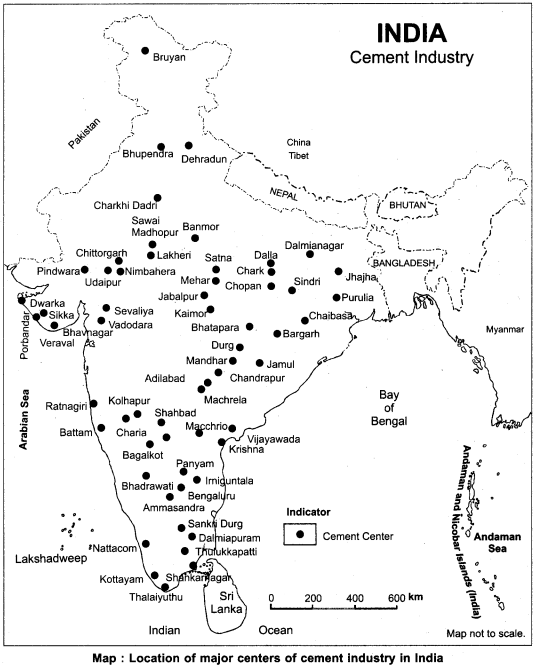
- Facility of transportation
- Connectivity to power sources
- Market facilities
- Availability of cheap and skilled labour
- Captial arrangement
- Arrangement of fresh water
- Finance and banking facilities
- Government encouragement
Distribution of cement Industry:
In India, 74% of total production is received from Gujarat, Rajasthan, Tamil Nadu, Bihar, Madhya Pradesh, and Jharkhand states etc. In big plants of cement, 77 plants are located in Andhra Pradesh, Rajasthan, and Tamil Nadu. Top 20 companies of cement industries produce more than 70% cement.
Major cement productive states are the following:
1. Tamil Nadu:
Major centers – Shankar Durg, Dalmiapuram, Pulpur, Aaila, Madurai, Alugang etc.
2. Madhya Pradesh:
Major centers – Jamul, Satna, Maihar, Kaisun, Gopal Nagar, Ankle Tara, Banyor, Neemuch, Gwalior, Katni and Damoh etc.
3. Andhra Pradesh:
Major centers – Machraila, Mangalgiri, Panyam, Krishna, Vijayanagar, Tandur, Mancherial, Yerragutla, Bugnipali, Kistrina, Perapalli, Nalkonda, Hyderabad, Adilabad etc.
4. Rajasthan:
Major centers- Lakheri, Nimbahera, Chittorgarh, Udaipur, Beawar etc.
5. Gujarat:
Major centers – Sikka, Porbandar, Dwarka, Ranavab, Okhla Mandal, Ahmedabad etc.
6. Karnataka:
Major centers – Bagalkot, Bari, Bhadrawati, Bengaluru, Kurkanta, Shahbad, Aamsandra, Bijapur, Gulbarga, Tulkur etc.
7. Jharkhand:
Major centers – Sindri, Dalmia Nagar, Khelari, Japla, Chaibasa, Banjari, Kalyanpur etc.
8. Uttar Pradesh:
This is a new cement producing state. Churk, Chopan and Chunar are major cement producing districts.
Besides, these in Haryana – Surajpur, Charkhi Dadri, In Maharashtra – Chandrapura, In Odisha- Hirakund, Rajagpura, In Kerala – Kottayam, In Jammu and Kashmir – Bruyan and in Meghalaya small cement plants are established.
Question 2.
Describe briefly the factors affecting localisation of cotton textile industry in India and mention major cotton textile producing centers.
Answer:
Factors affecting the localisation of cotton textile industry in India:
In India, the factors affecting localisation of cotton textile industry are-availability of raw material, local cheap labour, market, cheap hydroelecrticity, local investment and facility of ports etc. Cotton is a pure raw material whose weight does not reduce in manufacturing process, that is why, at present, most of the cotton textile industries are located near cotton producing areas.
At present, tendency to set up cotton textile industry near market is seen, and market demand decides what type of clothes should be produced. With the development of hydroelectricity, cotton textile industry could be established from cotton producing areas. Most of the cotton textile mills of Tamil Nadu are established due to cheap hydro electricity power.
Local Availability of Cheap Labour:
On this basis cotton, textile industries are established in Ujjain, Bharuch, Agra, Hathras, Coimbatore, and Tirunelveli. With local investment point of view, industries are established in Mumbai and Kanpur. In Kolkata, these textile mills are established due to port facility.
Major centers producing cotton textile:
This industry has developed mostly in Gujarat, Maharashtra, West Bengal and in Tamil Nadu, while Mumbai and Ahmadabad are the most important centers of cotton production.
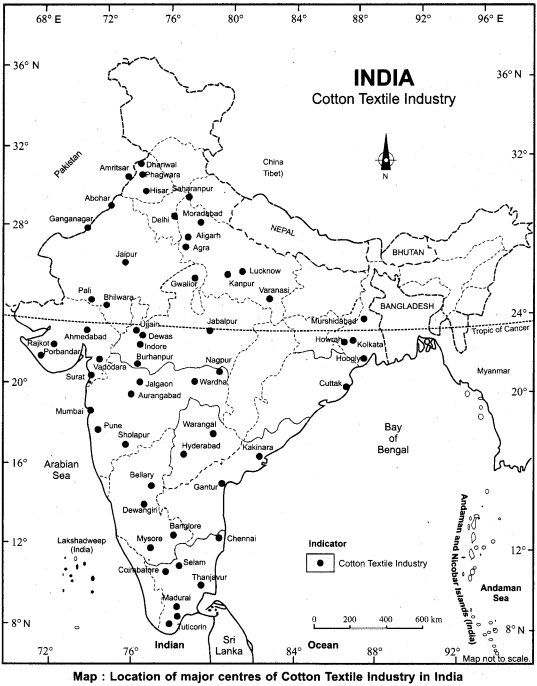
At present, among the cotton producing states of India, following places of cotton textile industry are important:
1. Gujrat:
Ahmadabad, Vadodara, Surat, Rajkot, Porbandar, Himmat Nagar.
2. Maharashtra:
Mumbai, Pune, Jalgaon, Aurangabad, Sangli, Kolhapur, Sholapur, Nagpur, Wardha, Satara.
3. Karnataka:
Hubli, Mysore, Bengaluru, Devangiri, Bellary, Gulbarga, Chhunli.
4. Madhya Pradesh:
Indore, Ujjain, Devas, Burhanpur and Gwalior.
5. Tamil Nadu:
Chennai, Coimbatore, Thanjavur, Tirunelveli, Tuticorn, Selam.
6. Andhra Pradesh:
Guntur, Kakinada, Godavari, Secunderabad.
7. West Bengal:
Murshidabad, Howrah, Hooghly, Kolkata, and 24 Parganas.
8. Uttar Pradesh:
Varanasi, Kanpur, Lucknow, Aligarh, Agra, Muradabad, Saharanpur, Modinagar, Hathras.
9. Delhi:
Shahdara.
10. Telangana:
Hyderabad, Warangal.
11. Rajasthan:
Bhilwara, Banswara, Udaipur, Beawar, and Pali.
Question 3.
Describe the localisation and distribution of sugar industry in India.
Answer:
India is the formost country in sugarcane and sugar production. India produces almost 8% sugar of the world.
Factors of Localisation of Sugar Industry:
Sugarcane is an exclusive raw material for this industry. In total weight of sugarcane, 9 to 12% sucrose is found. It is a crop of weight loss. Quantity of sucrose decreases from cutting of sugarcane to carrying it to the mill. If the juice is extracted in sugarcane mills within 24 hours of cutting sugarcane, then the amount of sugar is more in it, after this the amount of sugar decreases as time passes. That is why, most of the sugar mills are established near sugarcane producing belt. Sugar industry is a raw material oriented industry.
Major Sugar Producing States of India:
Maharashtra, Uttar Pradesh, Tamil Nadu and Karnataka are the major sugar producing states of India, while Bihar, Punjab, Haryana, and Gujrat are other sugar producing states of the country.
1. Maharashtra:
It has first place in sugar production. It produces 1/3rd part of the total production of the country. There are 134 sugar mills running in this state, which seems like a narrow strip from north Manmad to Kolhapur (south).
2. Uttar Pradesh:
It has second place after Maharashtra. In this state, sugar industry is centered in two belts.
(i) Ganga – Yamuna Doab:
Saharanpur, Muzzafarnagar, Meerut, Ghaziabad, Baghpat, Bulandshahar etc. are major producing districts.
(ii) Low land area:
Lakhimpur ICheri, Basti, Gonda, Gorakhpur, Bahraich are major producing districts.
3. Tamil Nadu:
Sugar mills of this state are running in- Coimbatore, Vellore, Tiruvannamalai, Tiruchirappalli, Ramnathpuram.
4. Karnataka:
Belgaum, Bellary, Mandya, Shimoga, Bijapur and Chitradurg are major producing districts. In this state, sugar industry is spread from east Godavari to west Godawari in coastal region.
5. Bihar:
Champaran, Saran, Darbhanga, Patna.
6. Rajasthan:
Keshoraipatan, Sri GangaNagar, Bhopalsagar.
7. Punjab:
Navashahar, Dhoori, Hoshiarpur, Gurdaspur, Amritsar.
8. Haryana:
Yamunanagar, Panipat, Rohtak, Sonipat, Palwal.
9. Gujarat:
Ahmedabad, Bhavnagar.
